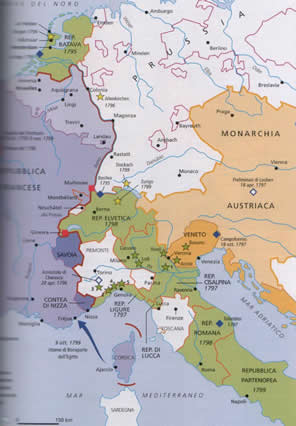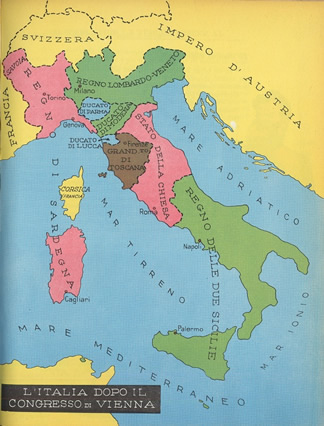
Italy in 1806.

Crest of Venice during the First French Empire, 1813.

Consequences of the Treaty of Campoformido in Italy.

Italy after the Congress of Vienna.

Monument of Daniele Manin.





No video
The 19th Century saw continuing shifts in power, from Austrian rule to French rule and vice-versa.
The Austrians began to reorganise the administration of the Venetian provinces, and this process was boosted when the Veneto region became part of the Kingdom of Italy under the Treaty of Pressburg in 1806 .
The French Emperor Napoleon, who had been calling himself the King of Italy since 1803, returned to Venice and introduced a series of major changes .
The status of the city was reduced to that of a "free port": public funding stimulated new business for the Arsenale and the Chamber of Commerce, as well as investments in new port facilities and lagoon defences. The plan of the city was studied and altered, involving the demolition of many buildings and clearing of areas to allow for gardens and parks and the creation of a central cemetery. All the welfare and corporate associations were banned, as well as some religious societies. Compulsory conscription was introduced.
After the Congress of Vienna in 1814-15, sanctioning the end of the Napoleonic Empire , Venice was returned to Austria and became the seat of the Austrian governor who the Emperor Francis II charged with continuing Napoleon’s public works and reforms. Primary education and bureaucracy were improved. The railway bridge across the lagoon was built in 1846, thus increasing tourism and trade and marking the end of the city’s insular status.
However the Austrians never managed to be completely accepted by the Venetians and, in 1848, Venice headed the long list of cities that revolted against the established powers in Europe. The first insurrection in the fight for Italian independence took place in Venice, organised by a group of intellectuals, owners, patriots and professionals supported by the popular masses.
On 16th March 1848 people invaded the prisons and released the patriot Daniele Manin who then set up a new government on 22nd March, though this only lasted one year, but was truly representative of the Venetians desire to become free of the Hapsburgs.
On 23rd March Carlo Alberto of Savoy, King of Sardinia, declared war on Austria and so started the first Italian war of independence. Venice, however, had to wait until the end of the third war to join the new unified Italy: this ended on 3rd October 1866 in Vienna with the signing of the peace treaty.
The Veneto region, no longer under Austrian rule, was annexed to the Kingdom of Italy by a referendum on 21st October of that year: it was a unanimous decision, 674,426 votes in favour and just 69 against.
1800 - 2000 - - rev. 0.1.6